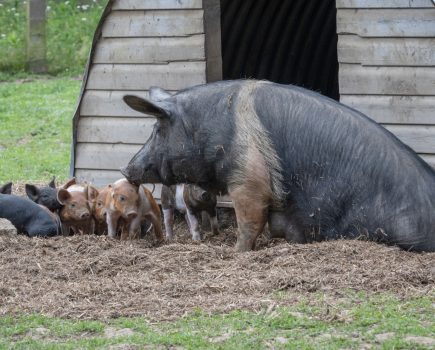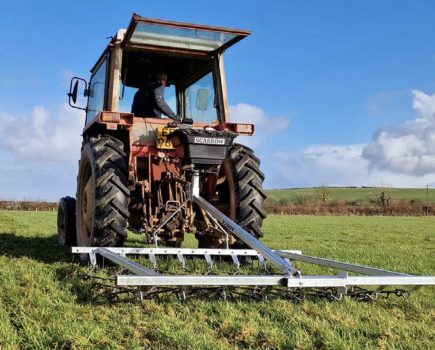John Wright meets a couple of full-time smallholders in the Pennines who have created a remarkable little farm through sheer hard work, a frugal lifestyle and a deep understanding of the land
This story is not about a sizable sow called Bessie, although one Keystone Cops experience in their early years certainly gave Richard and Stephanie Proud a baptism of fire.
When they began farming in the ruggedly picturesque hills around the village of Middleton-in-Teesdale in County Durham 18 years ago, Richard and a friend towed a box-trailer to Cumbria to collect this 60-stone (381kg), 9-foot (2.7m) pig from a muddy field. Bogged, the owner suggested they drive along the railway line as the next steam train wasn’t due for 20 minutes, so off they went; then a chuffing sound. Narrowly escaping, they reached a roundabout where a tiny swerve sent the pig crashing out onto a dual carriageway, refusing to move. Three police cars, six police officers, 16 council workers and two trucks later, it was problem-solver Richard who got this team to re-build the trailer around Bessie!
Richard and Stephanie are remarkable for being full-time smallholders. Told they’d never make a living on 16 acres they knew the only way they’d achieve the idyllic rural life was by leaving behind things they’d taken for granted. Richard told me, “We knew we’d have to be imaginative. We wanted to feed ourselves the best meat whilst treating our animals with respect. We were prepared to live in a way others may consider frugal and it’s deeply rewarding.”
Despite no farming experience it worked, gradually. “I went part-time at first,” says Richard, “Three months later I gave my job up. Stephanie stayed in hers for six years before we both became full-time smallholders.” Richard was a health services manager and Stephanie a university lecturer. Richard was for diving, metaphorically, from the high board (“I bought a tractor without knowing how to drive one”), Stephanie was the cool head and together their business plan developed. “We looked at how we could make the most of each asset,” says Richard, the creation of a ½-acre campsite being essential to the venture for additional income and as a market for the farm’s meat.
Their land has meadows with dry-stone walls and hedges with mature trees, and bits of ancient bluebell woods. “We liked the idea of having breeds that were here 100 years ago, so we started with Shorthorn cattle, longwool Teeswater Sheep and old-fashioned pig breeds,” says Richard. “Teeswater wool is beautiful. We wanted to add value so we learnt to spin. There’s a lot of potential in wool, Quality fleece might fetch £3/kg from the British Wool Marketing Board but if we wash it and spin it into yarn we can sell it for ₤100/kg.”
“Selling direct to spinners and knitters gives a much better return and is more rewarding. “We export most to Germany and Russia,” he says. “We can’t meet demand. The reputation of British wool is still very strong abroad especially for quality longwools.” They have six Teeswaters, one Black Wensleydale, two black Bluefaced Leicesters and various crosses; including some from a Jacob tup producing dark brown wool in big demand in the craft industry.
“We have a small butchery shop” explains Richard, “selling home-grown pork, beef, lamb, and ‘Renaissance mutton’ produced to a quality standard. It’s usually a castrated male (wether) butchered at 2½ years in the autumn after grazing on good grass, then hung for two weeks. We get two fleeces from each wether and a sheepskin rug at the end.” They have two cattle, a Luing and a British White, and butcher one fat beast a year, also butchered at 2½ years. Six rare breed piglets are bought in and fattened each year to 100kg live weight. They have nine free-range chickens, nine others recently killed in their first ever fox attack.
Success has come through an uncompromising approach to quality, epitomised in a commitment to conservation. “It’s very important,” Richard says, attributing stock health and flavour in meat to plant diversity. “Our land has a very rich traditional un-fertilised sward. Every year we’ve seen new species of wild flower appear, such as annual herbs Yellow-Rattle (Rhinanthus minor – seed rattles when shaken) and Eyebright (Euphrasia species). This area is becoming known for botanical tourism. Hay meadows of near-by lone farmer Hannah Hauxwell led to her becoming famous in 1961 when discovered living a tough life in fairly remote country, farming in a very traditional way.” Now 87 and living in the village, people still flock to Hannah’s Meadows (an SSSI) as they do to Highside Farm.
Richard picks people’s brains: it was a botanist camper who helped them apply for the Higher Level Stewardship scheme, important in helping the farm survive as a low input, quality output business. Richard pointed out that although DEFRA preferred awarding this status to bigger farms the staff from English Nature have been most encouraging and helpful since joining the scheme.
Richard and Stephanie knew farming would mean doing it tough. Richard says, “We knew we’d have to be willing to live in a way others would consider frugal.” Paying off their “fairly derelict traditional North Pennine farmhouse” (with byre for cattle, pig house, hay barn, stables and tractor shed) helped them take the final step. They go without inessentials but it doesn’t mean evenings staring at the wall. Stephanie is helping Richard catch up on the history of film so they watch DVDs, or play chess and music. Quite often they eat at the pub: the beef not up to their standard, they order fish!
“It’s been very interesting and exciting. We’ve become quite attached to the land and you start getting a deep understanding of how it works,” says Richard. They grow five acres of hay, remove animals in May and cut late July/August. “One year I was baling and going round the field the wrong way, bales having to be moved each time. Two neighbours looked over the wall and debated whether to tell Stephanie. They did. The first time I used a muck spreader a neighbour made sure I’d connected it up safely.”
One farmer with 2,000 sheep and 80 cattle asks politely how their lambing went. It surprises them. “Farmers judge you by how well you look after your animals and for being a good neighbour,” says Richard. “We feel very close to the local community; they’ve been amazingly helpful. They make fun but do so at each other.” One farmer restored their byre using traditional materials and methods won the AONB Conservation Award 2004 for his trouble.
Their meat room has a fridge (for curing bacon and hams), five freezers (800 litres total) and a stainless steel work-table where Richard makes mince, bacon, sausages and ham. “The lambs are cut up at the abattoir; the pigs and cattle by our local butcher. We have a bacon slicer, Trading Standards-approved scales (important if you sell), small sausage maker, and an economical small-scale Italian vacuum packer (Tre Spade, ₤178) with embossed bags.
After years of trying to perfect their operation in harmony with nature, Richard and Stephanie Proud remember it started with Bessie. Deciding eventually to buy in piglets to fatten because rooting would erode their sloping ground, they do miss porcine artificial insemination as a sport: all that hopping to avoid being trodden on as half-ton Bessie circled contentedly while the neighbour lay on the pig’s back tickling her tummy, she was certainly their first teacher.
Their camping website: www.highsidefarm.co.uk
Their wool: www.fleecetoyarn.co.uk
Richard and Stephanie’s Tips for small farm survival
1. Forget holidays. You will love being at home anyway.
2. Run an old car. Farming will only ruin a new one.
3. Learn to repair things yourself. Why should someone else have all the fun?
4. Add value to your produce by selling to the end user.
5. Install solar panels, heat pumps, insulation. A wood burner uses fuel from the farm.
6. Be happy with ramshackle buildings until you can repair them yourself.
7. For bigger projects find a builder who will let you work with him. You will learn so much.
7. Keep a paid job going until farm income is liveable and pay off mortgage before going full-time.
8. Understand the various grant schemes and be politely persistent.
9. Do your own tax returns, and grant applications. No accountants or land agents needed.
10. Older farm machinery is cheap and easier to maintain. For expensive items only used once a year it is better to pay a neighbour or contractor to do the job, i.e. cutting the hay.







